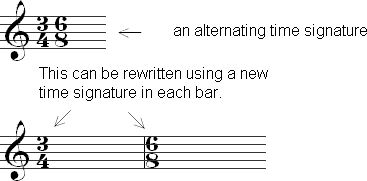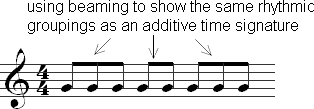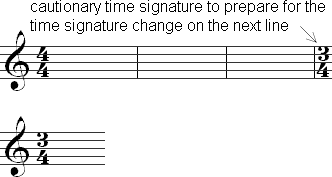Rhythm and Time Signatures
Parts of a Note
Rhythms in music are notated with various kinds of notes. Each note has certain characteristics that indicate the rhythmic value of that note. Notes have several parts:
Notehead
Oval-shaped Noteheads
The notehead is the oval shaped part of a note. It can be open or filled in.

Slashes
Several other kinds of noteheads are commonly used in guitar music. The first is the slash. This is often used for notating strumming patterns. Open diamonds or slanted box-shaped noteheads are used with the slashes to indicate certain rhythms.

Diamonds
Diamond noteheads are often used to indicate harmonics.

X-shaped Noteheads
Percussive techniques (pick scrapes, muted strings, etc.) are usually indicated with an 'X' notehead.

Stem
A vertical line attached to the notehead. The stem can be on the right or left side of the note and can point up or down. If the note is on or above the third line of the staff, the stem points down and is on the left side of the note. If the note is below the third line, the stem will point up and is placed on right side of the notehead. Note that this is a general rule and the stem direction will depend on other factors, such as the stem direction of other notes in a group of notes and clarity in music with multiple voices.

Flag
Flags are attached to the end of the stem on the right side of the line. A note can have multiple flags if the note value is small enough.

Beams
A beam is a horizontal line that connects two or more notes. Beams are used in place of flags when groups notes occur that could otherwise be notated with flags. The beams simplify the grouping of rhythms into units called beats. It is possible for a group of notes to have multiple beams depending on the rhythm.

Dots
Dots appear to the right of a notehead. They increase the value of the note by half. For example, if the value of a note is two beats, a dot would increase the note value by one for a total of three beats. It is possible to have multiple dots on a single note. Each dot after the first one increases the value of the note by half the value of the previous dot.
Dots beyond a single dot are rare, but occur frequently enough that it is worth knowing how they work.

Note Values
| Image | Name | Description |
|---|---|---|
 |
double whole note | equal to two whole notes, rarely used |
 |
whole note | open notehead without a stem |
 |
half note | open notehead with a stem, equal to 1/2 of a whole note |
 |
quarter note | filled-in notehead with a stem, equal to 1/4 of a whole note |
 |
eighth note | filled-in notehead with a stem and a single beam or flag, equal to 1/8 of a whole note |
 |
sixteenth note | filled-in notehead with a stem and two flags or beams, equal to 1/32 of a whole note |
 |
thirty-second note | filled-in notehead with a stem and three flags or beams |
Note values beyond thirty-second notes are possible, but don't occur very often.
Tuplets
Tuplets are rhythms where a beat is subdivided into smaller note values other than the normal subdivision. For example, a quarter note in 4/4 time can be subdivided into 2, 4, 8, and so on. Subdividing the beat into 3, 5, 7 or other numbers produces a tuplet. Tuplets are notated in several ways:
Number

Number and a Bracket

Ratio
The first number indicates how many notes are in the tuplet. The second number specifies the duration of the tuplet or how many notes of a certain value the first number replaces. An easy way to figure out tuplets with a ratio is to say "[first number] in the space of [second number]." For example, a sixteenth note quintuplet is indicated with the ratio 5:4, which can be read as, "five in the space of four." This means that there are five sixteenth notes in the space of four sixteenth notes.

Nested Tuplets
Tuplets can be nested. For example, in a sixteenth note quintuplet, the last two notes of the quintuplet could be replaced with a triplet.

Rests
Rests indicate a period of silence equal to the value of that rest. Each rest corresponds to one of the note values covered above.
| Image | Name | Description |
|---|---|---|
 |
double whole rest | rare, twice the value of a whole rest |
 |
whole rest | box hanging from the fourth line |
 |
half rest | box resting on the third line, half the value of a whole rest |
 |
quarter rest | squiggly line, 1/4 the value of a whole rest |
 |
eighth rest | slanted line with one flag, 1/8 the value of a whole rest |
 |
16th rest | slanted line with two flags, 1/16th the value of a whole rest |
 |
32nd rest | slanted line with three flags, 1/32nd the value of a whole rest |
Dotted Rests
Dots can also be used with rests. They affect rests in the same way that they affect notes.

Multimeasure Rests
Multimeasure rests indicate that there are multiple measures of rest. They are notated with number above the staff and a bolded horizontal line with vertical lines on each end. The number indicates how many measures of rest.

Time Signatures
Time signatures appear at the beginning of a piece of music after the key signature. They are also used any time the time signature changes. Unlike key signatures, they don't appear at the beginning of each line.
Ways of Writing Time Signatures
Two numbers one on top of the other.
The two numbers have different meanings depending on whether the time signature is simple or compound. Below are examples of two common time signatures:

Special Symbols
Symbols are often used for common time (4/4) and cut time (2/2). Music may be notated with the symbol or number, but not both. The symbols for these two time signatures appear about as frequently as the numbers.

Special Types of Time Signatures
Alternating Time Signatures
Time signatures may alternate between two time signatures throughout an entire piece. This is often notated by placing two time signatures next to each other at the beginning of the music rather than writing the time signature out for every measure.

Additive Time Signatures
Time signatures such as 3 + 2 + 3/4 are additive time signatures. The numbers at the top indicate a grouping of beats within a measure. For example 3 + 2 + 3/4 indicates that there is a total of eight beats in a measure and that they are grouped into a set of three beats followed by a group of two then a group of three beats. The first note of each group of beats is generally stressed so that the grouping of beats is discernable. Additive time signatures can be written as normal time signatures with beaming and/or accents to show how the beats should be grouped.

Below is an example of how the same thing can be notated using beaming to show the grouping of beats:

Cautionary Time Signatures
Cautionary time signatures occur at the end of a line of music to indicate that the time signature changes at the beginning of the next line of music.

Other Symbols Related to Rhythm
Ties
Ties are a curved line between two notes. They combine the rhythmic values of the two notes. The second note in the tie isn't played again. For example, a quarter note tied to an eighth note would be equal to one and a half beats in 4/4 time.

Multiple Tied Notes
It is also possible to have ties that span multiple notes. The note is played once, but is held for yhe value of all of the tied notes. This is shown below:

Ties look similar to slurs, but they are easy to tell apart. Slurs occur over two or more notes of differing pitch, while ties always occur between two notes of the same pitch.
Fermatas
Fermatas indicate that a note should be held for longer that its written value. Notes with fermatas are often held for twice the value of the note, but it is up to the performer how long to hold the note.

Swing Rhythms
Swing rhythms are notated with a symbol at the beginning of the music showing that eighth notes or sixteenth notes are to be played swing style. Eighth and sixteenth notes in the music are written normally, but should be played with a swing rhythm.
Swung Eighth Notes
Swung eighth notes are indicated by the following symbol:

Swung Sixteenth Notes
Swung sixteenth notes are indicated by this symbol:

Canceling Swung Rhythms
Swing rhythms can be canceled by reversing the symbols above. For example, eighth notes can be canceled with the symbol below.

